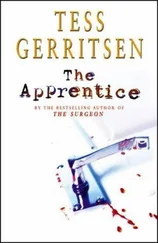She went very still in his arms, and he thought: I’ve crossed the line. Quickly he released her. “I’m sorry,” he said. “That should not have happened.”
“No. It shouldn’t have.”
“Can you forget it did?”
“Can you?” she asked softly.
“Yes.” He straightened. And said it again, more firmly, as though to convince himself. “Yes.”
She looked down at his hand, and he knew what she was focusing on. His wedding ring. “I hope for your wife’s sake that you can,” she said. Her comment was meant to instill guilt, and it did.
He regarded his ring, a simple gold band that he had worn so long it seemed grafted to his flesh. “Her name was Mary,” he said. He knew what Catherine had assumed: that he was betraying his wife. Now he felt almost desperate to explain, to redeem himself in her eyes.
“It happened two years ago. A hemorrhage into her brain. It didn’t kill her, not right away. For six months, I kept hoping, waiting for her to wake up….” He shook his head. “A chronic vegetative state was what the doctors called it. God, I hated that word, vegetative . As if she was a plant or some kind of tree. A mockery of the woman she used to be. By the time she died, I couldn’t recognize her. I couldn’t see anything left of Mary.”
Her touch took him by surprise, and he was the one who flinched at the contact. In silence they faced each other in the gray light through the window, and he thought: No kiss, no embrace, could bring two people any closer than we are right now. The most intimate emotion two people can share is neither love nor desire but pain.
The buzz of the intercom broke the spell. Catherine blinked, as though suddenly remembering where she was. She turned to her desk and pressed the intercom button.
“Yes?”
“Dr. Cordell, the SICU just called. They need you upstairs STAT.”
Moore saw, from Catherine’s glance, that the same thought had occurred to them both: Something has happened to Nina Peyton.
“Is this about Bed Twelve?” asked Catherine.
“Yes. The patient just woke up.”
Nina Peyton’s eyes were wide and frantic. Four-point restraints held her wrists and ankles to the bedrails, and the tendons of her arms stood out in thick cords as she fought to free her hands.
“She regained consciousness about five minutes ago,” said Stephanie, the SICU nurse. “First I noticed her heart rate was up, and then I saw her eyes were open. I’ve been trying to calm her down, but she keeps fighting the restraints.”
Catherine looked at the cardiac monitor and saw a rapid heart rate but no arrhythmias. Nina’s breathing was rapid as well, occasionally punctuated by explosive wheezes that expelled blasts of phlegm out the endotracheal tube.
“It’s the ET tube,” said Catherine. “It’s making her panic.”
“Shall I give her some Valium?”
Moore said, from the doorway, “We need her conscious. If she’s sedated, we can’t get any answers.”
“She can’t talk to you anyway. Not with the ET tube in.” Catherine looked at Stephanie. “How were the last blood gases? Can we extubate?”
Stephanie flipped through her papers on the clipboard. “They’re borderline. P02’s sixty-five. PC02 thirty-two. That’s on the T-tube at forty percent oxygen.”
Catherine frowned, liking none of the options. She wanted Nina awake and able to talk just as much as the police did, but she was juggling several concerns at once. The sensation of a tube lodged in the throat can induce panic in anyone, and Nina was so agitated that her restrained wrists were already chafed raw. But removing the tube carried risks as well. Fluid had accumulated in her lungs after surgery, and even while she was breathing 40 percent oxygen — twice that of room air — her blood oxygen saturation was barely adequate. That’s why Catherine had left the tube in place. If they removed the tube, they would lose a margin of safety. If they left it in, the patient would continue to panic and thrash. If they sedated her, Moore’s questions would go unanswered.
Catherine looked at Stephanie. “I’m going to extubate.”
“Are you sure?”
“If there’s any deterioration I’ll re-intubate.” Easier said than done was what she saw in Stephanie’s eyes. After several days with a tube in place, the laryngeal tissues sometimes swelled, making re-intubation difficult. An emergency tracheotomy would be the only option.
Catherine circled around behind her patient’s head and gently cupped her face. “Nina, I’m Dr. Cordell. I’m going to take the tube out. Is that what you want?”
The patient nodded, a response that was sharp and desperate.
“I need you to be very still, okay? So we don’t injure your vocal cords.” Catherine glanced up. “Mask ready?”
Stephanie held up the plastic oxygen mask.
Catherine gave Nina’s shoulder a reassuring squeeze. She peeled off the tape holding the tube in place and released air from the balloonlike inflator cuff. “Take a deep breath and exhale,” said Catherine. She watched the chest expand, and as Nina released the breath, Catherine eased out the tube.
It emerged in a spray of mucus as Nina coughed and wheezed. Catherine stroked her hair, murmuring gently as Stephanie fastened an oxygen mask in place.
“You’re doing fine,” said Catherine.
But the blips on the cardiac monitor continued to race by. Nina’s frightened gaze remained focused on Catherine, as though she was her lifeline and she dared not lose sight of her. Looking into her patient’s eyes, Catherine felt a disturbing flash of familiarity. This was me two years ago. Waking up in a Savannah hospital. Surfacing from one nightmare, into another…
She looked at the straps holding Nina’s wrists and ankles and remembered how terrifying it was to be tied down. The way she’d been tied down by Andrew Capra.
“Take off the restraints,” she said.
“But she might pull out her lines.”
“Just take them off .”
Stephanie flushed at the rebuke. Without a word she untied the straps. She did not understand; no one could understand but Catherine, who, even two years after Savannah, could not abide sleeves with tight cuffs. As the last restraint fell free, she saw Nina’s lips move in a silent message.
Thank you.
Gradually the beep of the EKG slowed. Against the steady rhythm of that heartbeat, the two women gazed at each other. If Catherine had recognized a part of herself in Nina’s eyes, so, too, did Nina seem to recognize herself in Catherine’s. The silent sisterhood of victims.
There are more of us than anyone will ever know.
“You can come in now, Detectives,” the nurse said.
Moore and Frost stepped into the cubicle and found Catherine seated at the bedside, holding Nina’s hand.
“She asked me to stay,” said Catherine.
“I can call in a female officer,” said Moore.
“No, she wants me,” said Catherine. “I’m not leaving.”
She looked straight at Moore, her gaze unyielding, and he realized this was not the same woman he had held in his arms only a few hours ago; this was a different side of her, fierce and protective, and on this matter she would not back down.
He nodded and sat down at the bedside. Frost set up the cassette recorder and took an unobtrusive position at the foot of the bed. It was Frost’s blandness, his quiet civility, that made Moore choose him to sit in on this interview. The last thing Nina Peyton needed to face was an over-aggressive cop.
Her oxygen mask had been removed and replaced with nasal prongs, and air hissed from the tube into her nostrils. Her gaze darted between the two men, eyes alert to any threats, any sudden gestures. Moore was careful to keep his voice soft as he introduced himself and Barry Frost. He guided her through the preliminaries, confirming her name and age and address. This information they already knew, but by asking her to state it on tape they established her mental status and demonstrated she was alert and competent to make a statement. She answered his questions in a hoarse, flat voice, eerily devoid of emotion. Her remoteness unnverved him; he felt as though he were listening to a dead woman.
Читать дальше












